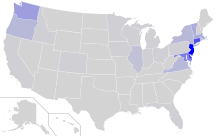Estonian Americans
This article needs additional citations for verification. (February 2023) |
 | |
| Total population | |
|---|---|
| 29,128 (2021)[1] 0.01% of the US population | |
| Regions with significant populations | |
| California · New York · New Jersey · Washington · Florida · Oregon | |
| Languages | |
| American English, Estonian | |
| Religion | |
| Protestant (Lutheran), Deism | |
| Related ethnic groups | |
| Estonian Canadians, Finnish Americans, Latvian Americans, Lithuanian Americans |
Estonian Americans (
History
| Estonian-American population as of the 2000 U.S. census[2] | |
|---|---|
| California | 3,465 |
| New York | 2,892 |
| New Jersey | 2,331 |
| Washington | 1,401 |
| Florida | 1,393 |
The first recorded arrival of immigrants from Estonia (then part of Sweden) to what is now the United States occurred already in 1627 in the colony of New Sweden along the Delaware River. Emigration from Estonia started on a larger scale in the late 19th century, when Estonia was part of the former Russian Empire, and continued until the mid-20th century. However, it is difficult to estimate the number of Estonian-Americans before 1920, since they were often referred to as "Russians" in the national censuses.[3]
The beginnings of
During World War II, Estonia was invaded and occupied by the Soviet Union in 1940–1941, and by Nazi Germany in 1941–1944. In 1944, in the face of the country being re-occupied by the Soviet Red Army, 80,000 people fled from Estonia by sea to Germany and Sweden, becoming
Some thousand of them moved on from there and settled in the United States. After the war's end, these
Notable people
President
Conductor
Chemist
In journalism,
Alar Toomre is an astronomer recognized for his research on the dynamics of galaxies. The Toomre sequence and Toomre Instability are named in his honor.
In entertainment, singer and actress
Hollywood actor Johann Urb (born January 24, 1977) is an Estonian living and working in the United States.
Psychologist, psychobiologist and neuroscientist Jaak Panksepp (June 5, 1943 — April 18, 2017) coined the term 'affective neuroscience', the name for the field that studies the neural mechanisms of emotion.
Toomas Hendrik Ilves, born December 26, 1953, in Sweden but raised in New Jersey, was the President of Estonia.
See also
- European Americans
- Hyphenated American
- New York Estonian House
- Estonia–United States relations
- Estonian Canadians
References
- ^ a b "Table B04006 - People Reporting Ancestry - 2021 American Community Survey 1-Year Estimates". United States Census Bureau. Archived from the original on 17 September 2022. Retrieved 17 September 2022.
- ^ People of Estonian Ancestry, U.S. 2000 Census
- ^ OCLC 166387368.
- ^ "Estonians in North America, 1627-1896".
Further reading
- Aun, K. The Political Refugees: A History of Estonians in Canada (McClelland and Stewart, 1985)
- Granquist, Mark A. "Estonian Americans." in Gale Encyclopedia of Multicultural America, edited by Thomas Riggs, (3rd ed., vol. 2, Gale, 2014), pp. 97-106. Online
- Kulu, H. and Tammaru, T. "Ethnic return migration from the East and the West: the case of Estonia in the 1990s", Europe-Asia Studies (2000) 52#2: 349�69.
- Pennar, Jaan; Parming, Tönu; Rebane, P. Peter (1975). The Estonians in America, 1627-1975: a chronology & fact book. Oceana Publications. OCLC 1288426.
- Tannberg, Kersti, and Tönu Parming. Aspects of Cultural Life: Sources for the Study of Estonians in America (New York: Estonian Learned Society in America, 1979).
- "Estonians" in Stephan Thernstrom, Ann Orlov and Oscar Handlin, eds. Harvard Encyclopedia of American Ethnic Groups (1980) Online
- Tammaru, Tiit, Kaja Kumer-Haukanõmm, and Kristi Anniste. "The formation and development of the Estonian diaspora." Journal of Ethnic and Migration Studies 36.7 (2010): 1157-1174. online
- Walko, M. Ann. Rejecting the Second Generation Hypothesis: Maintaining Estonian Ethnicity in Lakewood, New Jersey (AMS Press, 1989).
External links
- Estonian Americans at Countries and Their Cultures

